Searching for the perfect wood for your cabinets? Explore top options, balancing durability, cost, and style to create your dream kitchen. Intrigued? Read on!
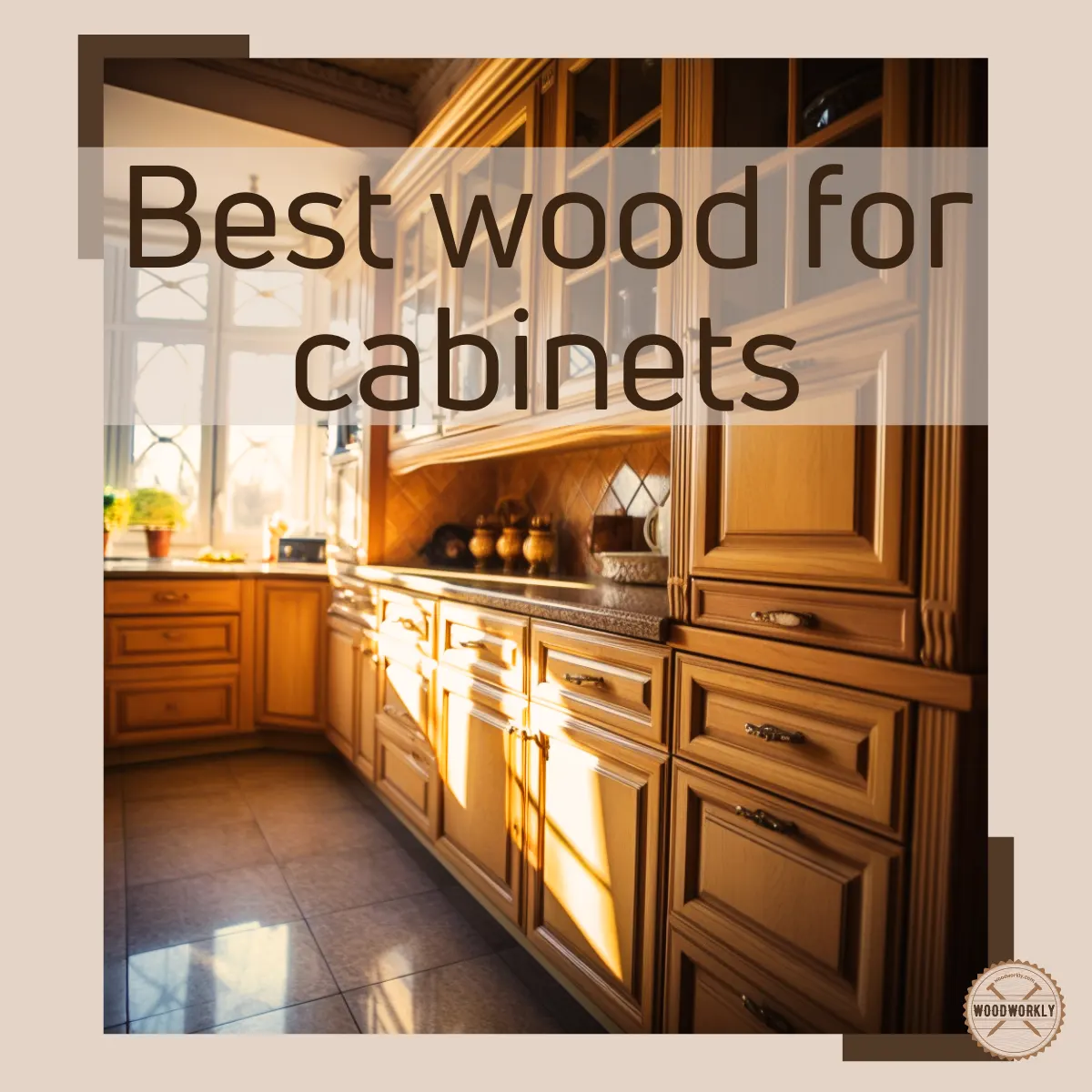
Cabinets provide practical storage solutions in our homes, allowing us to organize and declutter our living spaces.
Not only that, but cabinets also offer an opportunity for homeowners to express their personal style and taste, with a wide array of materials, designs, and finishes available.
I remember years ago when I first dipped my toes into the world of woodworking, I found myself pondering a question that many of us have faced: which wood is best for crafting beautiful and durable cabinets?
So, I did some research and asked for an expert’s advice for selecting wood for cabinets.
Now, with years of experience in the cabinetry industry here’s what I know about, The Best wood for cabinets,
Pine, Oak, Poplar, Hickory, Maple, Mahogany, Cherry, Ash, Beech, Birch, Walnut, Spruce, Douglas Fir, Alder, Bamboo, and Plywood are the best wood for cabinets. Many kinds of wood are perfect for cabinets if they support weight, are durable, consist of good quality wood grades, and have an aesthetic look and style.
But there’s more to know before you’re selecting the right wood to use.

If you wish to display decorative items, should focus on the color and design of the wood. But if you’re willing to store heavy items, you need to focus more on strength.
In this article, we’re diving deep into the best wood for cabinets with the pros and cons of each wood, types of cabinets, and wood types that suit them perfectly.
I have answered some frequently asked questions as well.
Below I have discussed in-depth 16 best wood for cabinets.
Just keep reading!
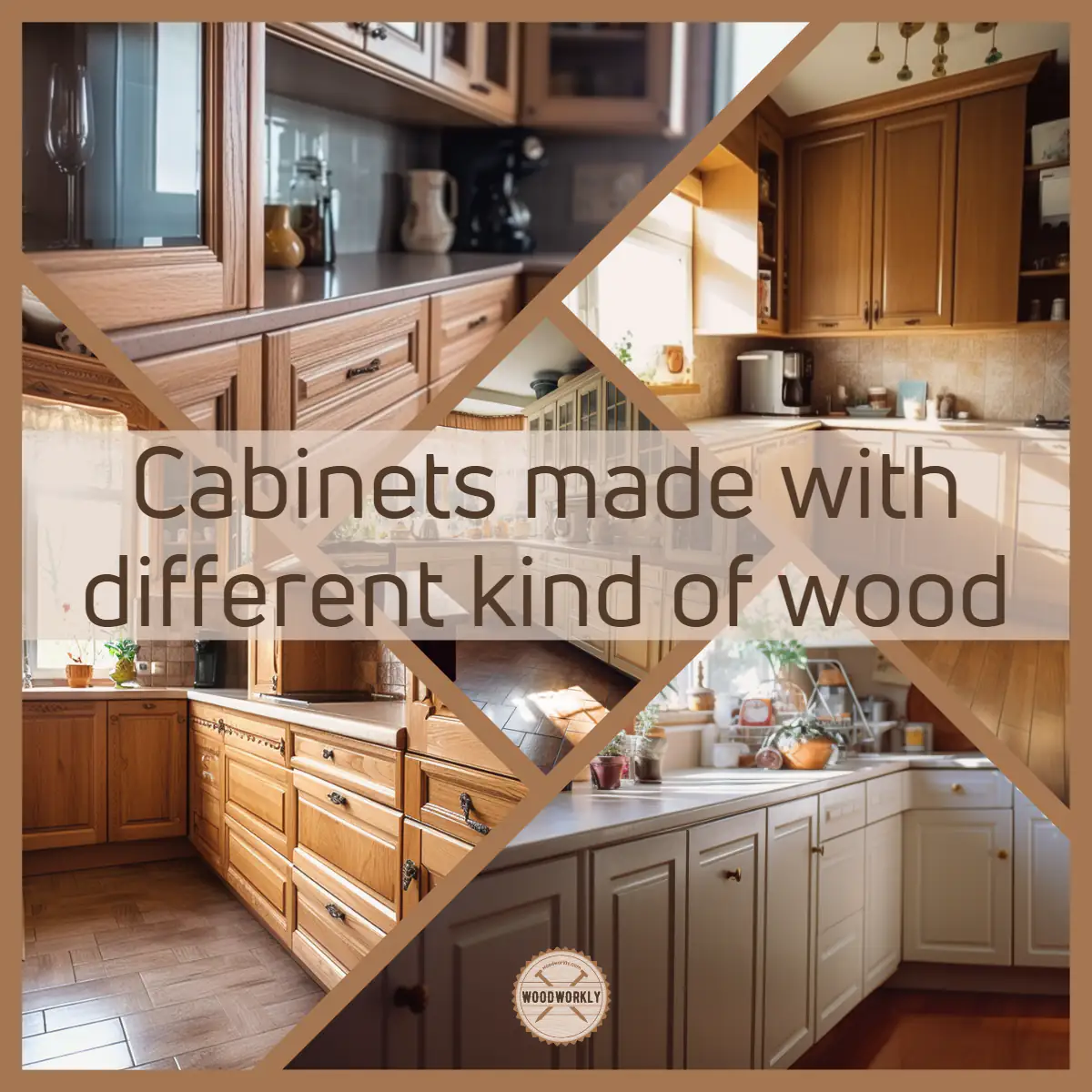
First of all, let’s have a look at the factors you need to consider when selecting a wood type for cabinets.
Factors to Consider When Choosing the Best Wood for Cabinets
Selecting the best wood for cabinet is a challenging task because each wood has its own advantages and disadvantages.
However, understanding the factors that influence your choice will make the decision-making process smoother.
Here’re the factors you need to consider when selecting wood for cabinetry,
- Durability and hardness of the wood
- Aesthetics and grain pattern
- Responsiveness to stains and finishes
- Cost and budget
- Sustainability and environmental impact
- Style and design compatibility
Let’s discuss those factors in detail to make your selection process a lot easier.
Durability and Hardness
The longevity of your cabinets largely depends on the wood’s durability.
Hardwoods like oak, maple, and cherry boast impressive resistance to dents and scratches, making them ideal for cabinets.
Conversely, softer woods like pine and alder might not withstand daily wear and tear as effectively.
Aesthetics and Grain Pattern
Different wood species exhibit unique grain patterns and colors, contributing to your kitchen’s overall appearance.
For a striking, bold look, opt for woods with distinctive grain patterns like hickory or ash.
If you prefer a more subtle, refined style, consider woods such as maple or cherry.
Responsiveness to Stains and Finishes
The way a wood takes stains and finishes can significantly impact the final cabinet look.
Some species, like oak, absorb stains more uniformly, while others, such as birch, might showcase blotchiness.
It’s crucial to consider how your desired finish will interact with the wood you choose.
Cost and Budget
Your budget plays a significant role in determining the wood you select.
High-quality hardwoods like cherry and walnut tend to be more expensive, while alternatives like oak, maple, or even engineered wood products can offer more budget-friendly options without sacrificing quality.
Sustainability and Environmental Impact
Eco-conscious homeowners might opt for sustainable wood options.
Look for woods sourced from responsibly managed forests, certified by organizations like the Forest Stewardship Council (FSC).
Bamboo and reclaimed wood are also environmentally friendly alternatives worth considering.
Style and Design Compatibility
The wood species you choose should complement your kitchen’s design and architectural style.
For example, a traditional kitchen might benefit from the warmth of cherry or the elegance of walnut, while a modern, minimalist design may call for sleek maple or even engineered wood with a high-gloss finish.
By carefully evaluating these factors, you’ll be well-equipped to make an informed decision and create cabinetry.
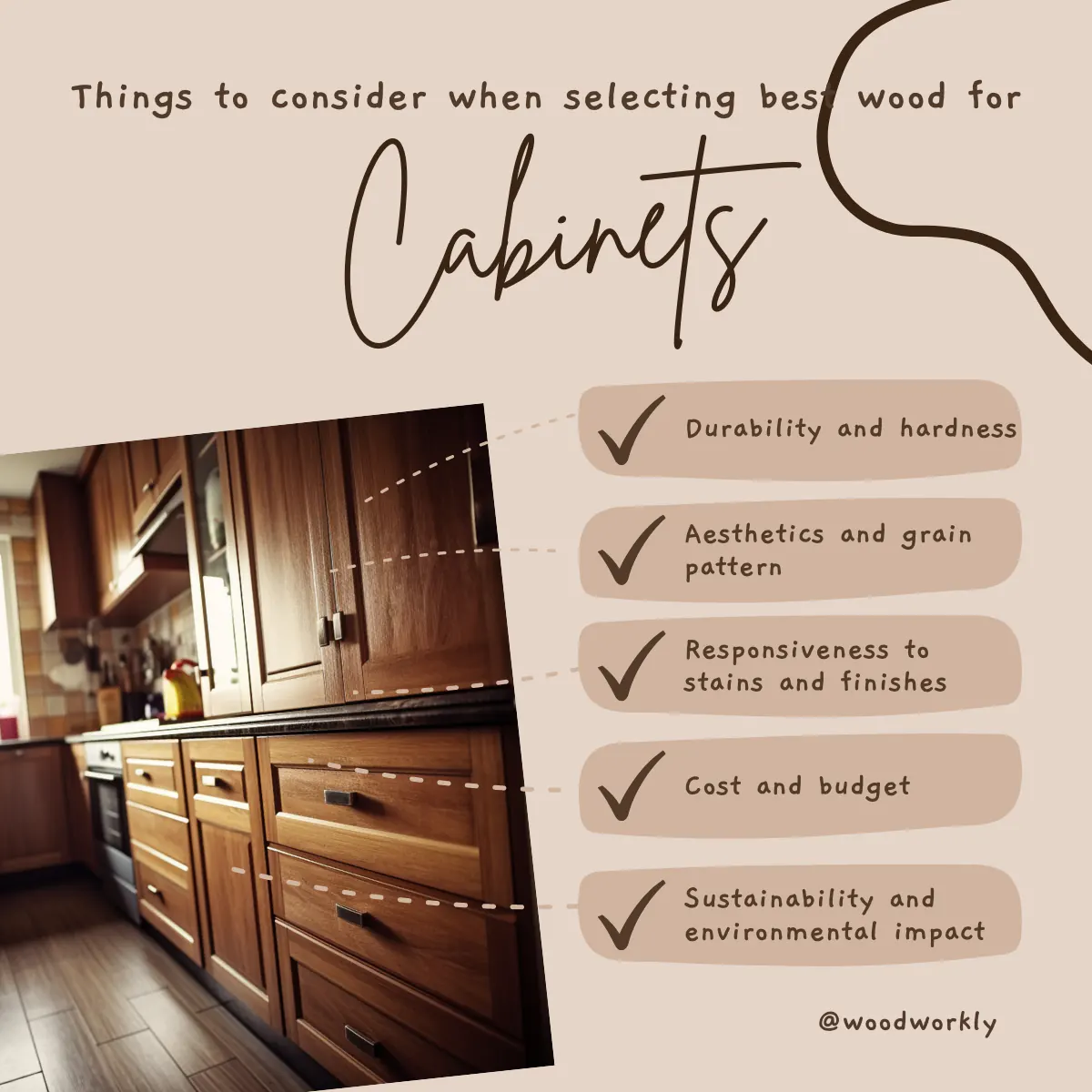
Let’s see what are the best wood for cabinets and talk about them in detail.
Best Wood For Cabinets
Consider the factors you’ve learned when selecting the wood that suits you the most for the cabinetry.
Let’s discuss each one of the woods that serves the best for cabinets with the pros and cons of each.
1. Pine
Pine is considered one of the best wood for cabinets because of its country, rustic appearance, and as a cost-effective option.
Pine wood cabinets are beautiful because of their soft amber color and smooth texture. The yellow hue of Pine wood adds a sunny, welcoming feel to the cabinets.
Pine is a softwood that is so much easy to work with. It is great for carving custom-made cabinets.
Therefore, if you’re a beginner in woodworking Pine wood is an excellent option for cabinetry. But on the other side, because of being so soft,
Pine is prone to dents and scratches. But that can be easily skipped if you maintain Pine cabinets properly.
Pine wood is easy to paint, stain, screw, and nail. The smooth texture of Pine wood holds paints so well.
If you keep Pine wood with a natural finish for so long, it’ll eventually turn into a beautiful patina that gives unique look to your cabinet.
Because of having good moisture resistance, both yellow Pine and white Pine are excellent for humid environments.
Pine is good to use for bathroom and kitchen cabinets.
Pine has many distinctive knots that change the cabinet surface individually with other markings.
Therefore, when you’re selecting Pine for cabinetry, make sure to inspect for knots.
Pine wood is well worth the price. It is cheaper than Maple, Oak, Cherry, and Mahogany.
Undoubtedly Pine is one of the best wood for cabinets with a rustic, retro look I’ve ever worked with.
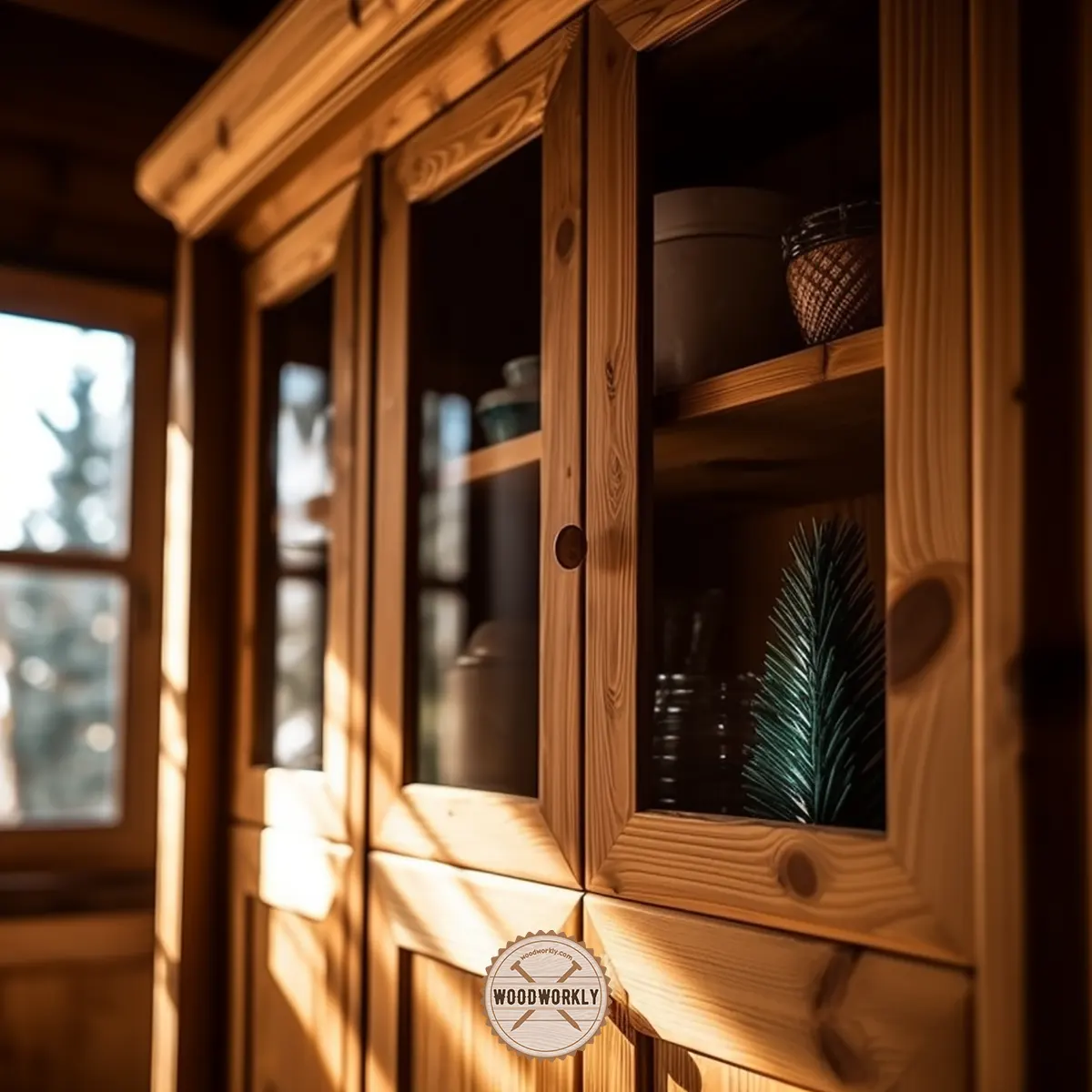
Pros and Cons of Pine as A Cabinet Material
| Pros | Cons |
| High workability | Poor durability |
| Easy to paint and stain | Need high maintenance |
| Beautiful rustic, country appearance | Susceptible to dents and scratches |
| Lightweight | Tear up easily |
| Affordable | |
| Resistant to swelling and shrinking | |
| Has good moisture resistance |
As you can see there’re lots of advantages of Pine for making cabinets than its disadvantages.
2. Oak
Oak is a wonderful choice for cabinets. It has a beautiful wood grain that adds a unique appearance to your cabinets.
Oak woodgrain feels so warm and cozy.
Oak cabinets don’t get old easily. They give a country, modern, farmhouse look to your cabinets.
Oak is a hardwood with excellent compressive strength, flexural strength, and hardness.
Therefore, Oak cabinets are extremely sturdy, strong, and durable. Not like Pine, Oak has good resistance to scratches and cracks.
It can easily withstand abuse without losing its dimensional stability.
Because of being so strong and heavy, Oak cabinets can hold heavy weights. You can place heavy items in your Oak cabinets with no worries.
Repairing Oak cabinets is also easy by sanding the chipped or damaged area.
Plus, Oak wood has good water resistance and can be used in humid environments like kitchen cabinets and bathroom cabinets.
Therefore, Oak is great as kitchen and bathroom cabinet material.
Oak is easy to stain and seal. It is a customizable solid wood with long-lasting capabilities.
Because of being water-resistant, durable, strong, and hardwood, Oak can easily last for many years.
Plus, Oak doesn’t contain harmful chemicals and it is an eco-friendly option.
There’re main 2 types of Oak I use for cabinet making. They are,
- Red Oak
- White Oak
Let’s see how useful Red Oak and White Oak are as cabinet materials.
Red Oak for Cabinets
Red Oak is excellent for cabinets. It has high hardness, according to the Janka hardness scale, Red Oak has a hardness rating of 1260 lbf.
Because of being so hard, Red Oak has high resistance against wear and tear. Red Oak has pink undertones that add uniqueness to your cabinets.
But, because of this pinkish undertone, Red Oak cannot be stained with white, grey, or light color stains. Pink color will peel off.
Red Oak has a deep color that won’t produce brighter color like White Oak. Red Oak is great for traditional interiors. If you’re into classical home stylings, Red Oak is the best wood for cabinets.
White Oak for Cabinets
White Oak has high durability than Red Oak. Therefore, with little maintenance, White Oak cabinets easily last over decades. White Oak is harder than Red Oak with a hardness rating of 1360 lbf.
White Oak is rot-resistant. Therefore, it is useful as outdoor cabinetry material.
Most people love the light color appearance of White Oak, and they only apply natural stains over White Oak.
Painting White Oak is considered a waste because White Oak is beautiful on its own.
Read my latest article to know, How to paint oak cabinets white without grain showing, the comprehensive guide!
Staining White Oak is so simple and easier than staining Red Oak.
Because of having gentle look, White Oak is great for modern interiors. White Oak is one of the best wood for cabinets.
Both Red Oak and White Oak are excellent options to use for cabinets.
But as per my experience, White Oak is slightly better than Red Oak in cabinetry because of its high strength and durability.
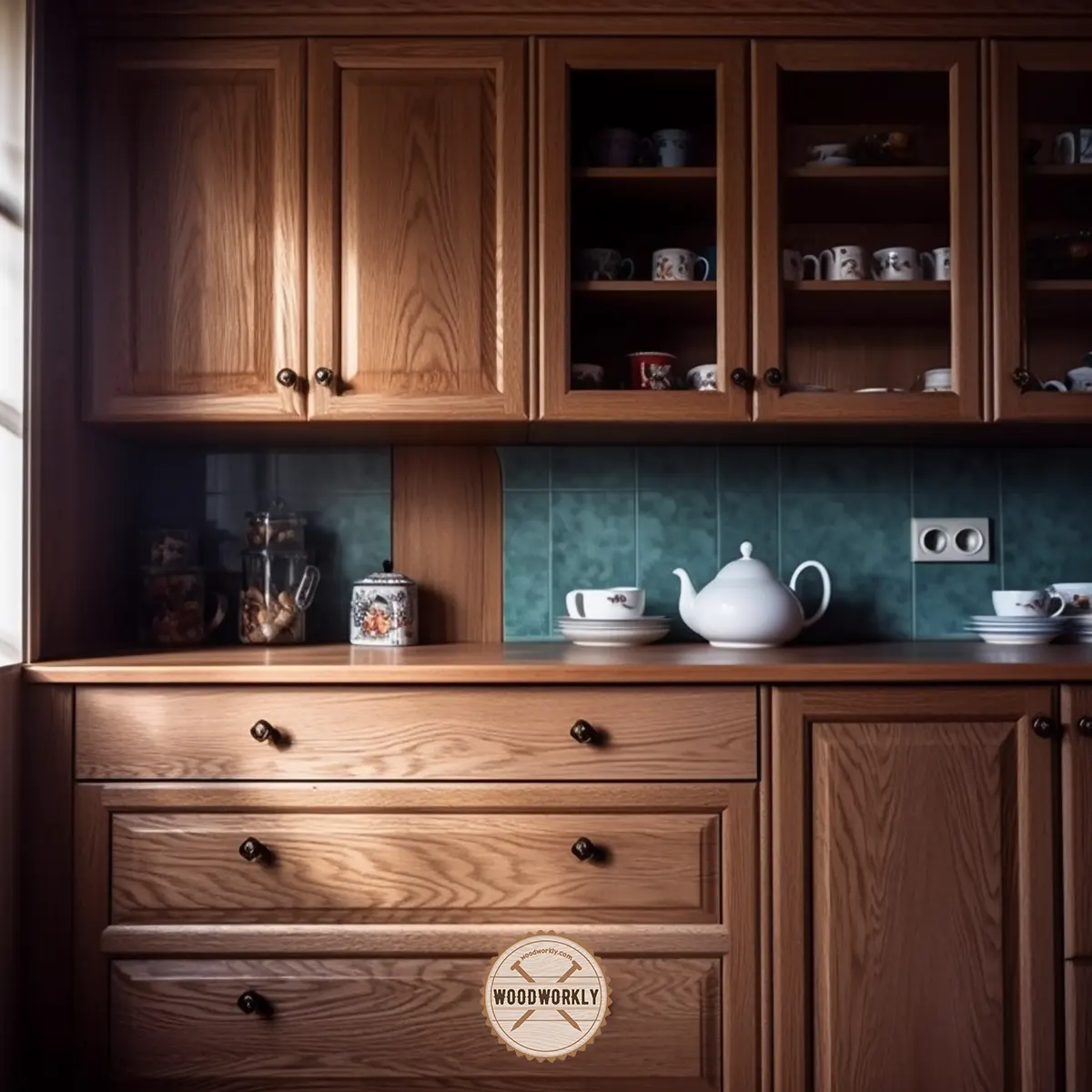
Pros and Cons of Oak as A Cabinet Material
| Pros | Cons |
| Sturdy | Heavy and difficult to move |
| Excellent strength | Darken over time |
| Easy to finish and stain | Expensive |
| Withstand heavy loads | High tannin content |
| Wear and tear-resistant | Difficult to cut and screw |
| High dimensional stability | |
| Easy to repair | |
| Need less maintenance |
3. Poplar
Poplar is one of the best paint-grade woods for cabinets. It is affordable and so easy to cut and mill. The Uniform texture of poplar adds a unique appearance to your cabinets.
Even though poplar is a hardwood, it belongs to the soft hardwood family that is softer than most the woods.
Therefore, nailing, and screwing with poplar is easy and it has high workability. Poplar is great for beginners in woodworking as well.
If you’re willing to paint the cabinets, Poplar is the best option for you. It takes paints so well and is able to get any color you wish.
The colors of poplar cabinets vary widely, and it doesn’t look great with the natural finish.
But on the other hand, poplar is extremely porous and soaks up paints like a sponge. An additional primer is required to control the absorption rate.
Poplar does not take stain well because of the nature of its fiber structure. If you use stain on Poplar cabinets, make sure to follow the correct procedure without ending up with a random blotchy, dull surface.
Poplar has poor dent resistance and applying a sealer, or any other protective layer is a must to last long your cabinets for years.
Poplar has poor dimensional stability because of its less dense annual rings.
Because of having a weed-like fiber structure, poplar tends to warp, and twist with environmental moisture and humidity. Therefore, Poplar is not good for bathroom cabinets.
Make sure to sand poplar with fine-grit sandpaper, because poplar tends to fuzz up during sanding.
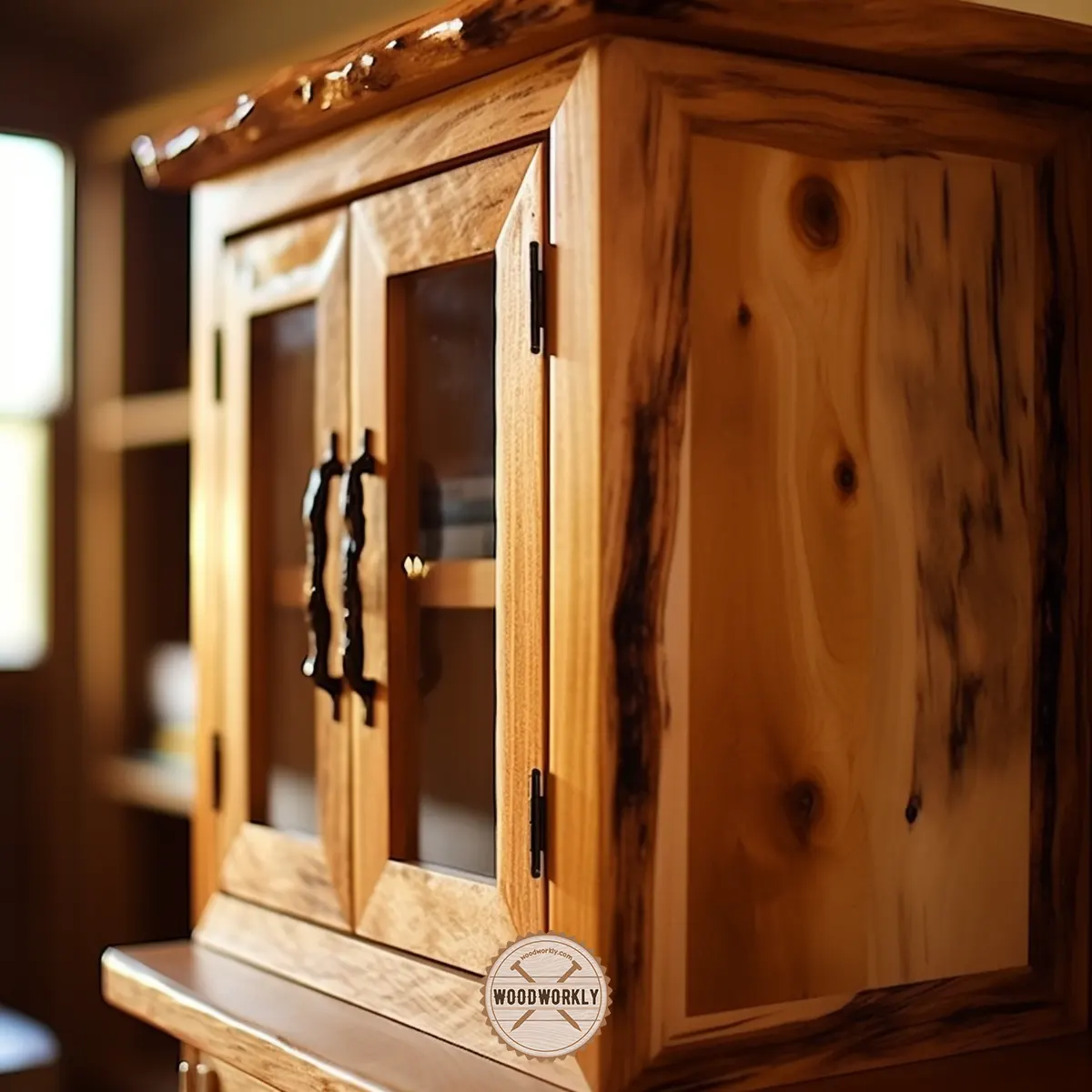
Pros and Cons of Poplar as A Cabinet Material
| Pros | Cons |
| High workability | Poor weather resistance |
| Easy to paint | Poor water resistance |
| Affordable | Poor dimensional stability |
| Lightweight | Susceptible to dents and scratches |
| Uniform texture | Too soft |
Most of the above disadvantages can fix with a good primer or sealer. Other than that, poplar has exceptional qualities to use as a cabinet material.
4. Hickory
Hickory has a natural contrasting appearance with a wide range of colors from white to reddish-brown. Therefore, you can easily match the color of Hickory cabinets to other furniture.
Hickory is stronger, tougher, and harder than Maple and Oak. It can hold heavy items without wear and tear. With its flame-like grain pattern, It gives a country, casual look to the cabinets.
Even though Hickory is a hardwood with extreme strength, it has poor water resistance.
Therefore, Hickory cabinets cannot be placed in a humid environment like a bathroom. Hickory for bathroom cabinets is not recommended.
Hickory is having high availability and it is easy to stain in a variety of colors from dark to light colors.
It has poor resistance against scratches and marks. Therefore, Hickory cabinets need high maintenance.
Cleaning with mild dishwashing detergent soaked in warm water is recommended to keep Hickory fresh and new.
For cleaning, never use harsh chemicals that contain silicone or bleach.
Because of having high compressive strength, flexural strength, and hardness, Hickory poplar for cabinets. But it is expensive.
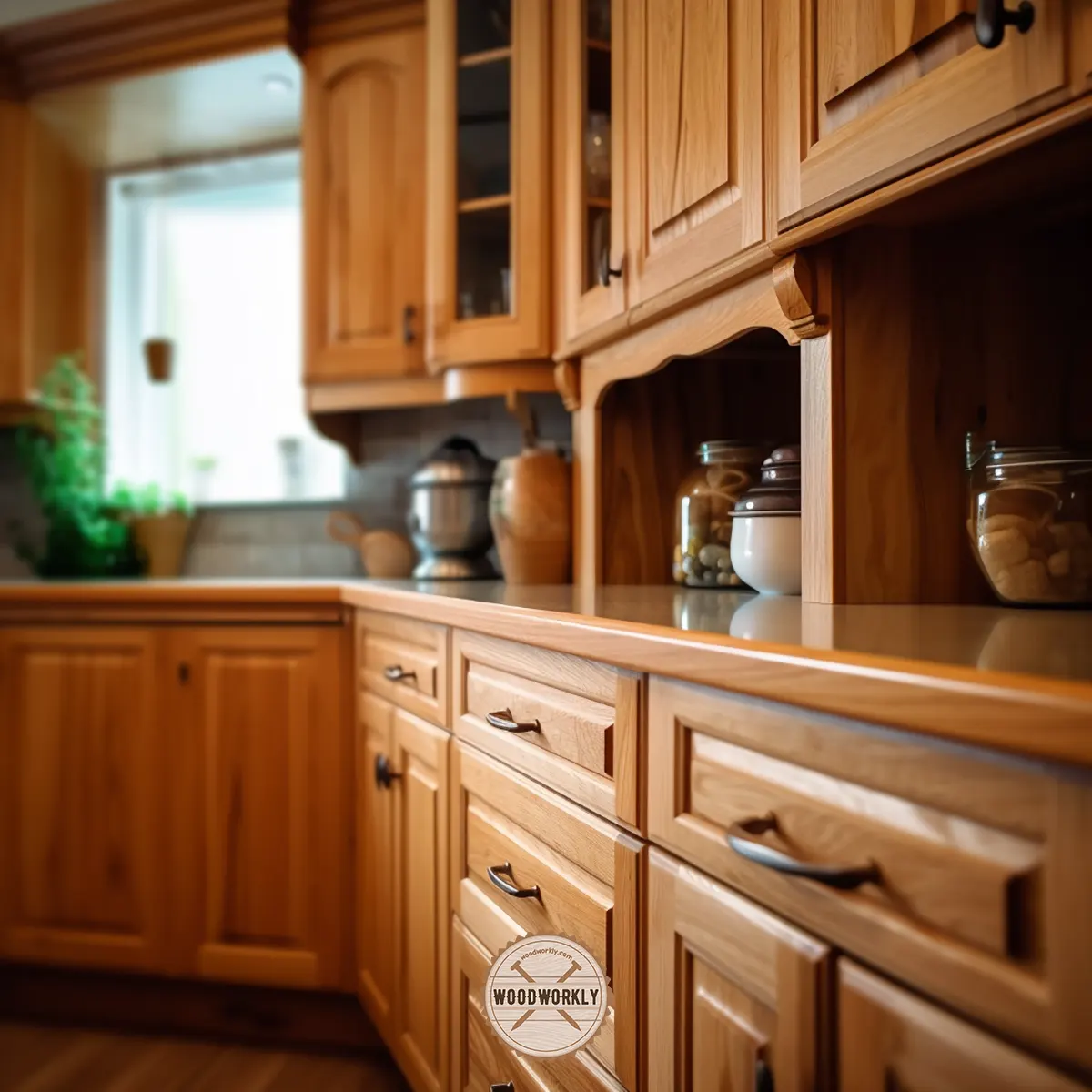
Pros and Cons of Hickory as A Cabinet Material
| Pros | Cons |
| High strength | Expensive |
| Easy to paint | Poor water resistance |
| Easy to stain | Susceptible to insect attacks |
| Wear and tear-resistant | Susceptible to dents and scratches |
| High durability | |
| Beautiful appearance with a variety of colors |
5. Maple
Maple is a hardwood with smooth wood grain and a non-porous fiber structure that is widely used for cabinets.
Maple is a tough and durable hardwood. Painting and staining Maple wood is so much easier than most other wood because of its great qualities. Therefore, Maple cabinets can be colored in any color you wish.
If you maintain Maple cabinets with proper care and regular maintenance, they will easily last over decades.
It is a customizable wood versatile wood that can be changed as we want.
Maple cabinets can color lighter or darker and can give a modern or classical look. Simply there are no exceptions in using Maple as a cabinet material.
Maple is cheaper than Cherry or Walnut. It is affordable and well worth the price.
High availability, durability, and high versatility make Maple wood one of the best for cabinets.
Maple cabinets can get yellow with age due to the high exposure to UV rays.
Therefore, make sure to apply stain, sealer, or any other protective layer that gives UV protection and protects your Maple cabinets from yellowing and damage caused by UV rays.
There’re mainly 2 types of Maple that we commonly use for cabinets. They are,
- Hard Maple
- Soft Maple
Hard Maple
Hard Maple is an extremely hardwood with a Janka hardness rating of 1450 lbf.
Cabinets that are made of hard Maple withstand against abuse and are resistant to dents and scratches.
Hard Maple shows burn marks and it has a smooth surface. Your woodworking tool needs to be well sharpened before working with hard Maple because it can fuzz with less sharp edges.
Hard Maple has the following qualities that are really important in making cabinets,
- The great natural beige appearance
- Superior hardness
- Easy to clean
- Withstand against the high force
- Eco friendly
Soft Maple
Soft Maple is also a hardwood with a Janka hardness of 950 lbf which is harder than Alder, Mahogany, Elm, and poplar.
Soft Maple tends to get a blotchy surface when staining than hard Maple.
Therefore, you should apply a pre-stain wood conditioner first before applying a stain on soft Maple cabinets.
It is a paint-grade wood with lots of unique qualities.
Overall, both hard Maple and soft Maple are excellent for cabinets.
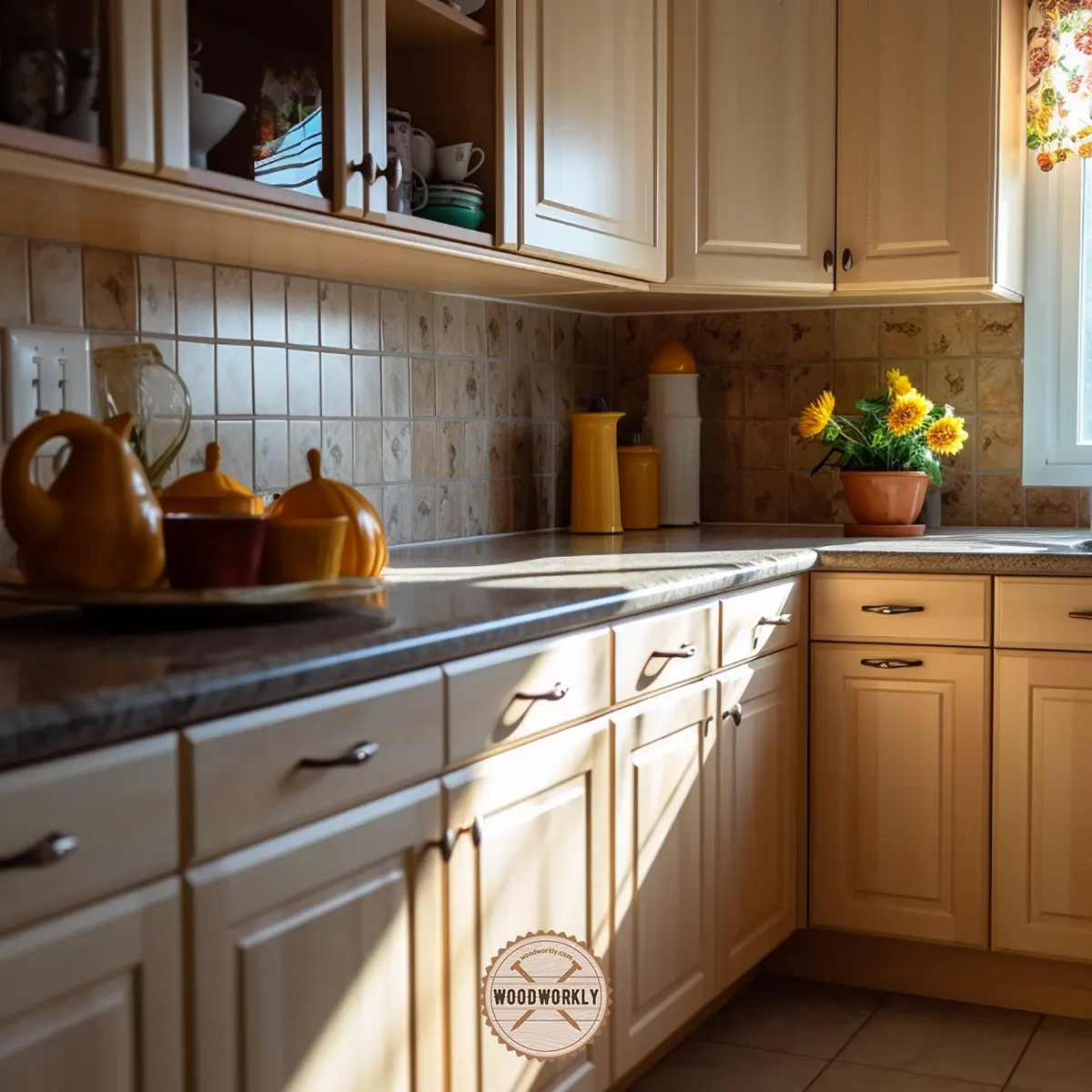
Pros and Cons of Maple as a Cabinet Material
| Pros | Cons |
| Easy to stain and paint | Can get yellow when get exposed to the sunlight over years |
| High durability | Susceptible to insect attacks |
| Versatile hardwood | Poor wear and tear resistance |
| Strong | |
| Affordable | |
| Moisture resistant | |
| Resistant to warping and shrinkage |
6. Mahogany
Mahogany is a kind of luxury type wood for cabinets because of its straight wood grain, great strength, and expansiveness.
Not many people use Mahogany for cabinets because of its less availability and high cost.
but Mahogany is one of the most beautiful woods for cabinets. It has a deep red color surface that glows when polished well.
Because of having straight grain and a glossy surface, you don’t need much wax to enhance its appearance.
The shine that Mahogany gives after polishing it up and cared for with regular maintenance,
can’t achieve with any other wood.
Simply, Mahogany is a type of wood that hard to be replaced and cabinets made from Mahogany are so simple to identify because of the highlighted qualities and appearance.
Mahogany is a hardwood with great strength and high durability. It is rot-resistant and lasts over decades with proper maintenance.
Mahogany gets deeper and darker color with age. Most people appreciate the rich look of Mahogany which add a new feel and look to your cabinets.
You can add finishes to get the darker color sooner. Mahogany is one of the best wood for cabinets.
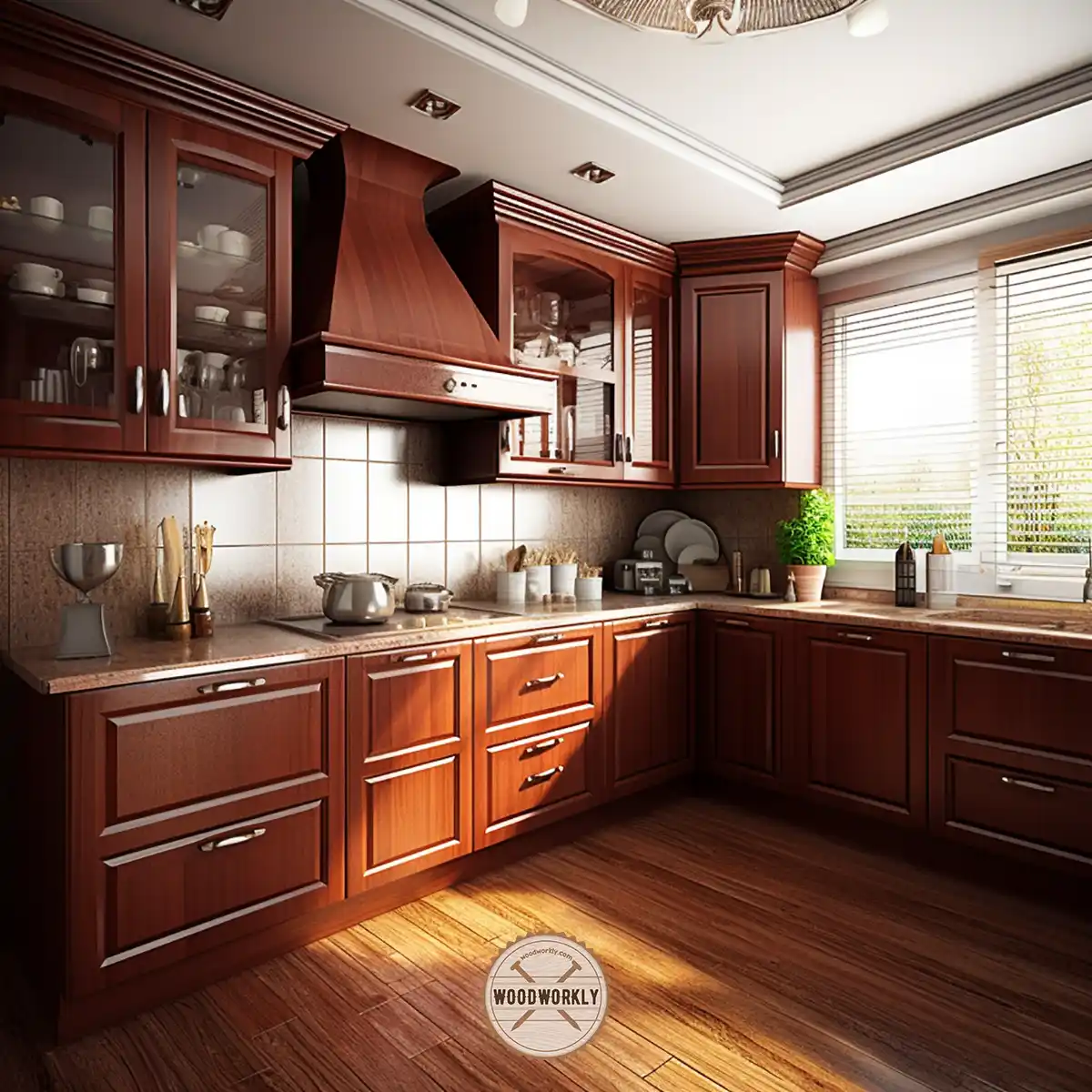
Pros and Cons of Mahogany as a Cabinet Material
| Pros | Cons |
| Need less maintenance | Expensive |
| High durability | Heavy |
| Strong and sturdy | Hard to find |
| Rich reddish-brown color | Darken over time |
| High water resistance | Difficult to handle |
| Easy to paint and stain |
7. Cherry
Cherry wood adds a unique aesthetic look to your cabinet. It has a beautiful reddish-brown texture with a closed-grain wood structure.
Woodgrain is diverse, and you can find many pins, curls, and knots in Cherry wood.
It is a traditional type of wood, and you can get a classical appearance with Cherry cabinets. But because of being a highly versatile wood, Cherry can be customized for modern homes as well.
Cherry gets darkened over years with the exposure to sunlight. So, make sure to apply stain, sealer, or any other protective layer that has sunblock agents to prevent the wood from getting darkened.
Staining and painting Cherry wood is so much easy and you can easily get a smooth finish as you wish with less wood finishing mistakes.
Therefore, even if you’re a beginner in woodworking, Cherry is a great wood to start your journey because of its friendly features.
Cherry cabinets look warm and inviting. Glazed Cherry cabinets are able to give a traditional look while protecting the darker stain.
When the Cherry wood gets darkened with age, it will shine more due to the reddish undertones. It is one of the best wood for cabinets.
Cherry has high workability. It has excellent gluing, nailing, polishing, and screwing properties that are important in cabinet making.
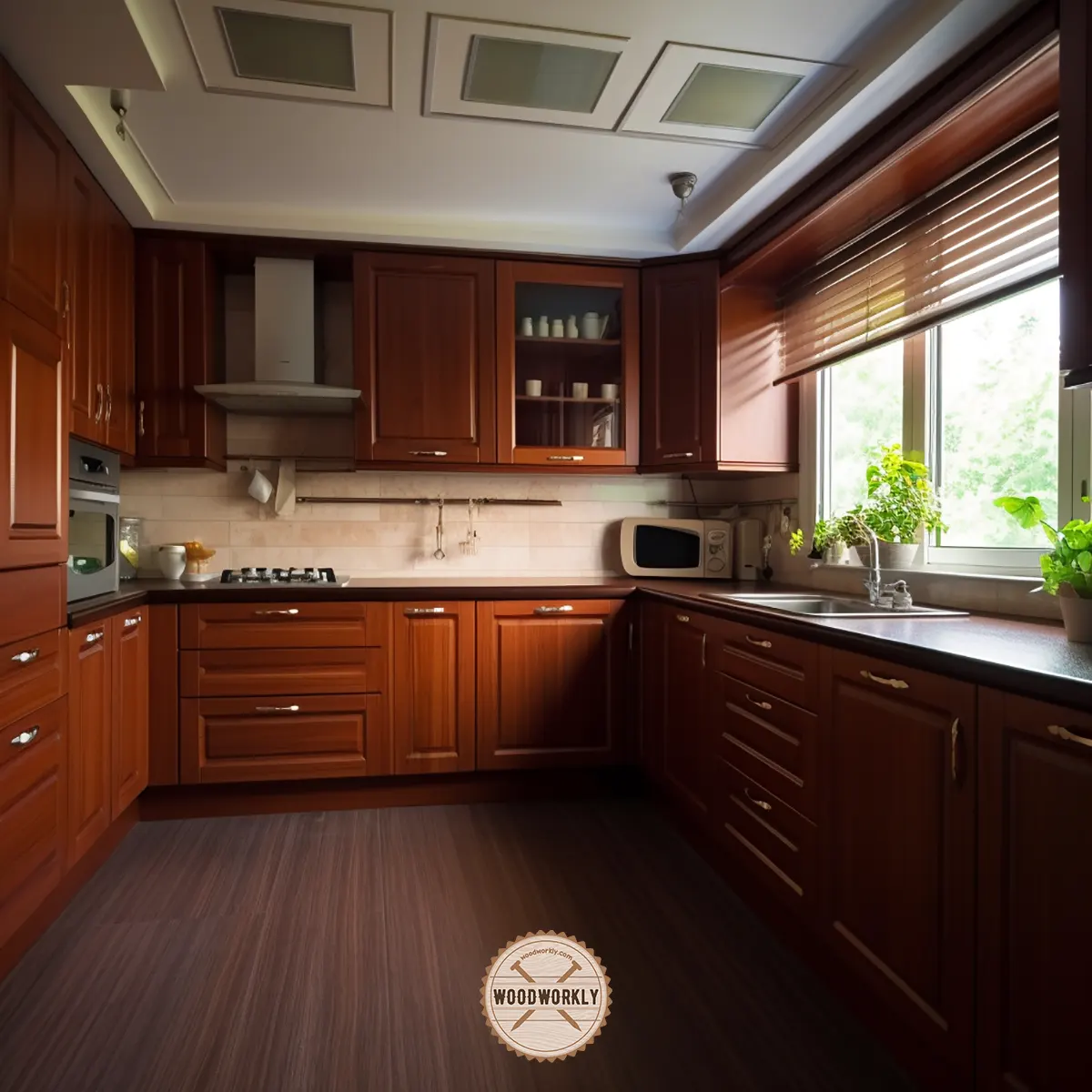
Pros and Cons of Cherry as a Cabinet Material
| Pros | Cons |
| Excellent finishing properties | Expensive |
| Lightweight | Poor resistance against dents and scratches |
| High workability | |
| Give a nice rich look with age | |
| Beautiful reddish brown smooth texture |
8. Ash
Ash is one of the best affordable options for cabinets.
It is evergreen and can be customized as we want to enhance its appearance and wood grain. it is aesthetically pleasing and excellent for cabinets with beautiful designs.
Ash is so strong, and it can hold heavy items without getting cracked or chipped. Because of its heavyweight handling capabilities, Ash can use for any kind of cabinet.
Staining, painting, and sealing Ash wood is so easy.
It gives an attractively unique appearance with a proper finish. If you pay more attention to detail, Ash is the wood for you.
Ash has shock resistance. If your Ash wood cabinets got hit hard because of heavy items, most of the shock force will absorb by the wood itself and protect it from splitting and cracking.
Even though most the hardwoods are heavy and difficult to move, Ash is surprisingly lightweight and can handle easily.
No harmful chemicals released by Ashwood and it’s an eco-friendly option.
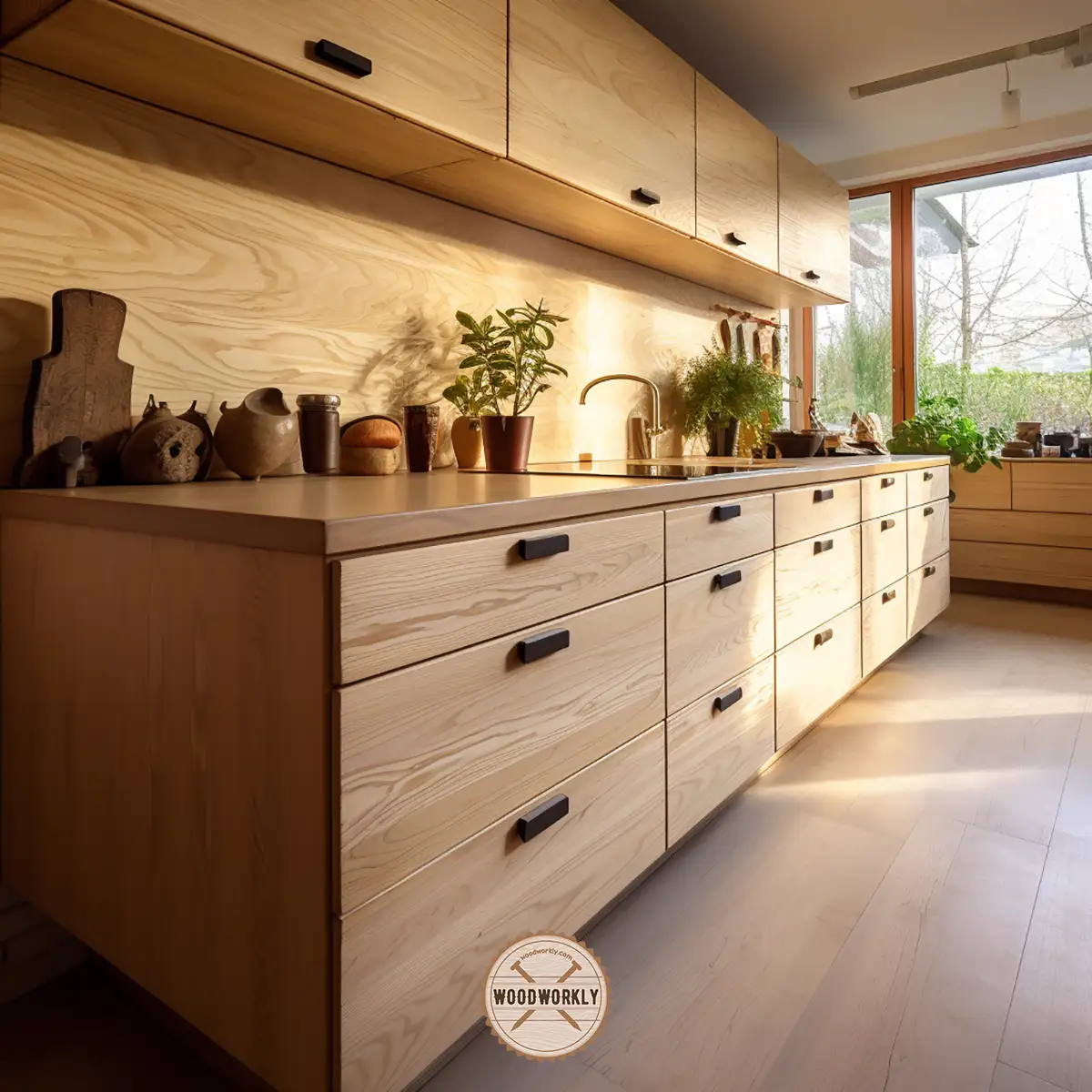
Pros and Cons of Ash as a Cabinet Material
| Pros | Cons |
| High hardness | Need high maintenance |
| High durability | Flammable than most woods |
| Strong and sturdy | Susceptible to insect attacks |
| Easy to paint and stain | Less availability |
| High workability | |
| Can be installed in larger spaces due to its high elasticity | |
| Beautiful light color and wood grain | |
| Able to hold heavy items |
9. Beech
Beech is one of the best hardwoods that is widely used for cabinetry. Beech belongs to the high-quality grade in the cabinet industry.
Beech has a beautiful texture and a more subtle grain. Painting and sealing are also easy with Beech because of their great finishing properties.
If you’re a beginner in woodworking, that look for hardwood to build a cabinet, Beech is one of the best wood cabinets you should go with.
Woodworking tools work well with Beech wood by making clean cuts and accepting stains.
You can give Beech cabinets any color you wish because it allows you to achieve your favorite style cost-effectively.
The only downside of Beech wood is its heaviness. Other than that, Beech is strong, rigid, and provides an elegant look to your cabinets.
Because of being hardwood with exceptional compressive and bending strength, Beech cabinets can hold heavy items without chipping, cracking, or damaging the wood itself.
Beech wood has no moisture resistance as many other hardwoods, therefore, before placing a Beech cabinet in a humid environment, make sure to paint, stain or seal the wood properly.
Otherwise, moisture can cause Beech wood to warp and twist.
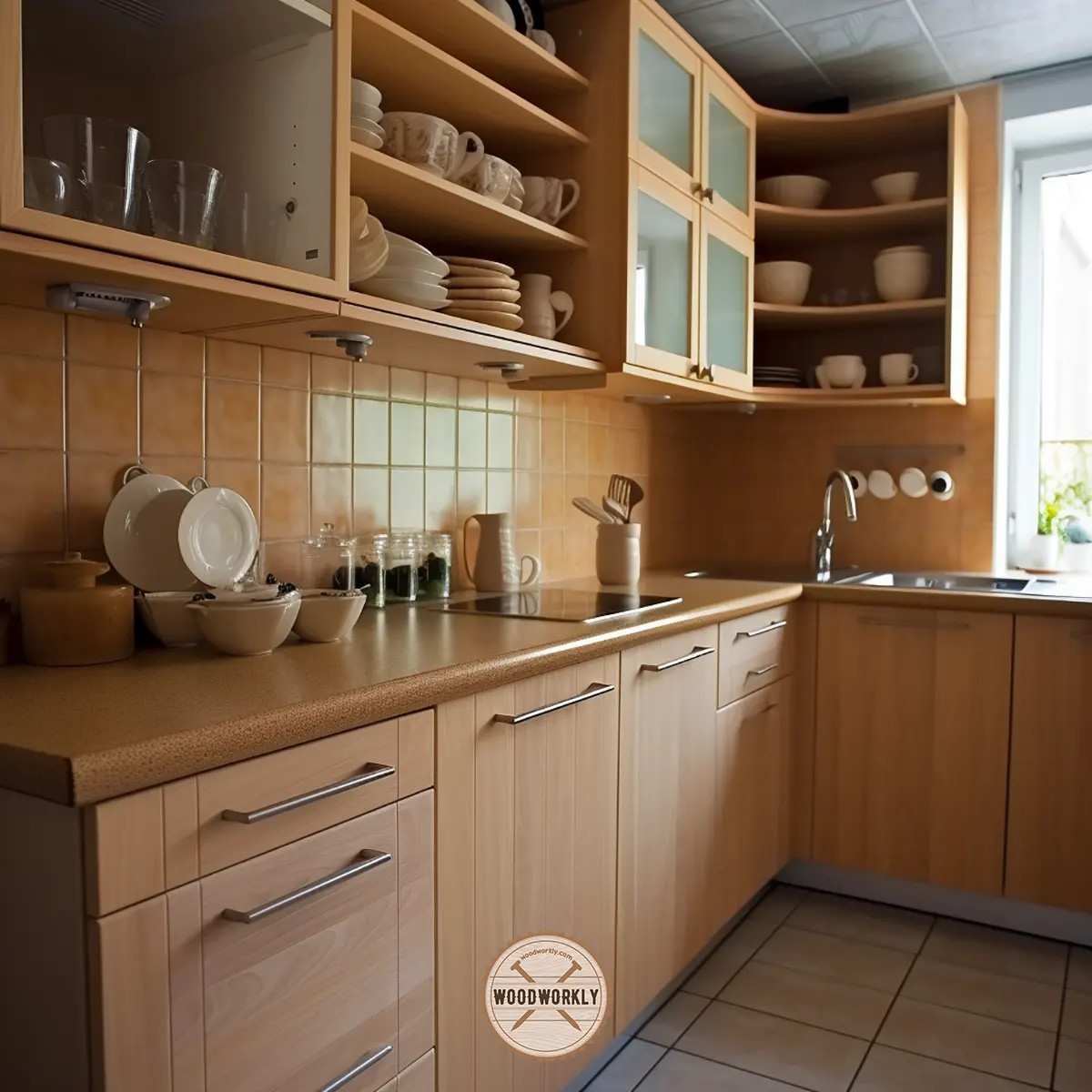
Pros and Cons of Beech as a Cabinet Material
| Pros | Cons |
| Strong | poor moisture resistance |
| Easy to paint and stain | Heavy |
| High workability | Expensive |
| Shock resistant | Susceptible to insects and pests |
| High durability | |
| Able to hold heavy items |
10. Birch
Birch is an excellent wood for cabinets with high durability and high tensile strength. It has a light brown or golden color that adds an aesthetic appearance to your loving cabinets.
For kitchen cabinets, Birch wood provides a modern, farmhouse, contemporary look.
Birch wood has a porous fiber structure. Therefore, it can easily absorb stains and turn into your desired style. It is easy to paint, stain and seal because of its great finishing properties.
As per my experience, Birch looks great with lighter wood stains which make the surface uniform and smooth. Because darker mix of wood stains may lead to discoloration and unevenness of the wood.
But on the other hand, Birch has an uneven texture that can easily get blotchy when applying stain.
Therefore, applying a pre-stain wood conditioner is a must when staining Birch cabinets to avoid random blotches and streaks.
Birch wood has excellent resistance against dents and scratches. Therefore, with little maintenance, Birch wood cabinets will last for years.
It is one of the most durable wood options for any kind of cabinet including kitchen cabinets, and bathroom cabinets.
Overall, Birch is a popular wood for cabinets due to its high versatility and availability.
It is less expensive and provides excellent qualities that make it well worth the price. Overall, Birch wood is best for cabinets.
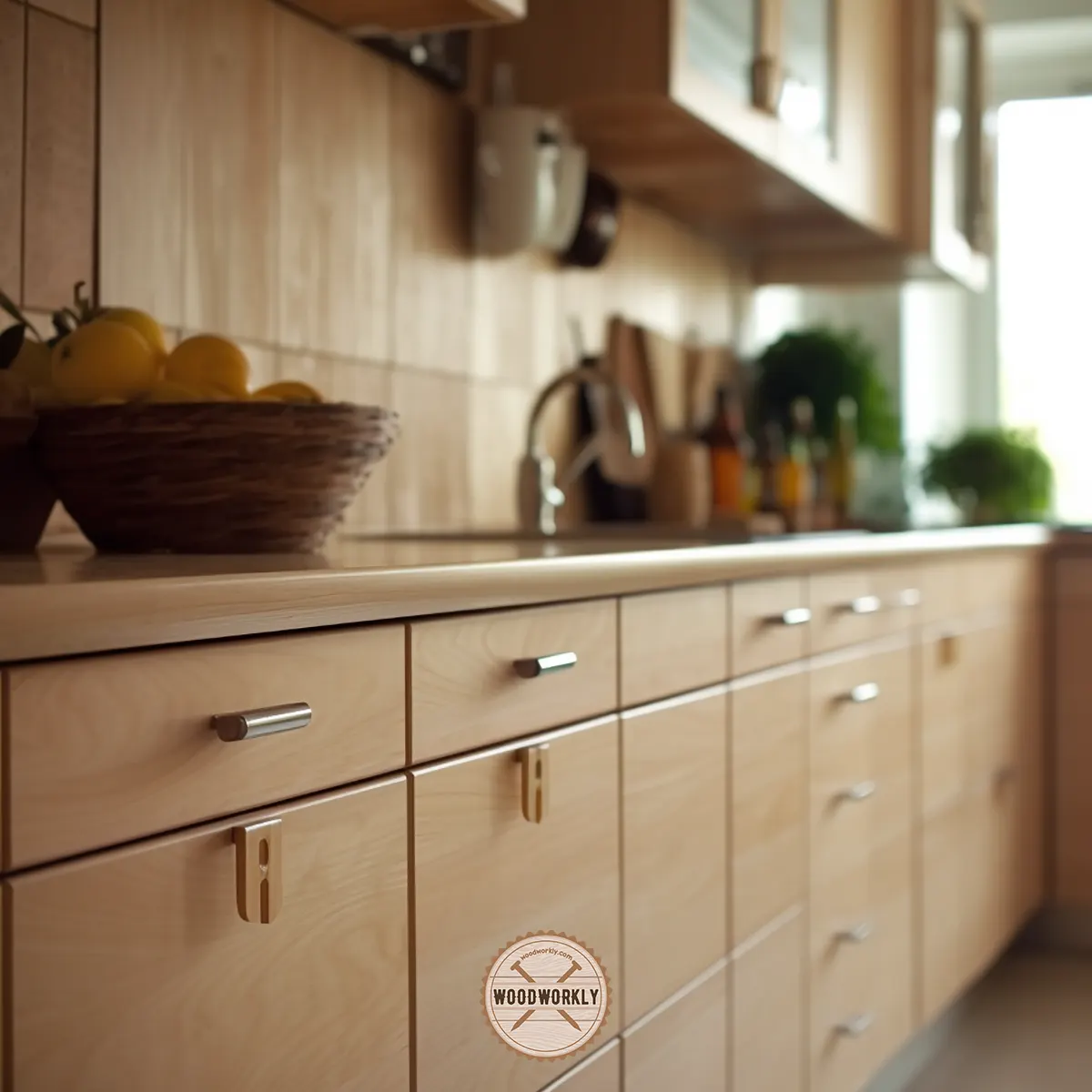
Pros and Cons of Birch as a Cabinet Material
| Pros | Cons |
| Easy to stain and paint | Uneven texture can result in a blotchy surface |
| Dent and scratch-resistant | No moisture resistance |
| Less expensive | No weather resistance |
| Modern look | Crack and warp easily in dry conditions |
| High workability | No shear and wear resistance |
| Natural decay resistance |
11. Walnut
Walnut is commonly used to make custom-quality cabinets. It is a hardwood with a high Janka hardness rating of 1,010 lbf which is higher than most other woods.
Because of being hard and dense, Walnut is extremely durable and has good resistance against dents and scratches.
Therefore, Walnut cabinets and tables are able to hold heavy items without chipping or cracking the wood. Walnut is the best wood for cabinets.
Plus, Walnut has good water resistance as well. Therefore, it can use to make bathroom cabinets.
But I highly recommend using protective sealer because wood is wood, and they aren’t water-resistant as artificial materials.
You can wipe Walnut cabinets without any fear of causing water damage or impurities. Therefore, keeping Walnut cabinets clean is so much easier than Birch wood cabinets.
Walnut is able to give luxurious look to your cabinets because of its fine wood grain and most importantly it has intricated grain style and dark color swirls of color that cannot be found in any other wood that use for cabinet making.
These stunning features make Walnut cabinets highlighted and unique.
Staining and painting Walnut is easy because of their great finishing properties. It gives a rich, warm look with natural stains.
Walnut cabinets turn into lighter colors with age. It creates a beautiful look for home interiors.
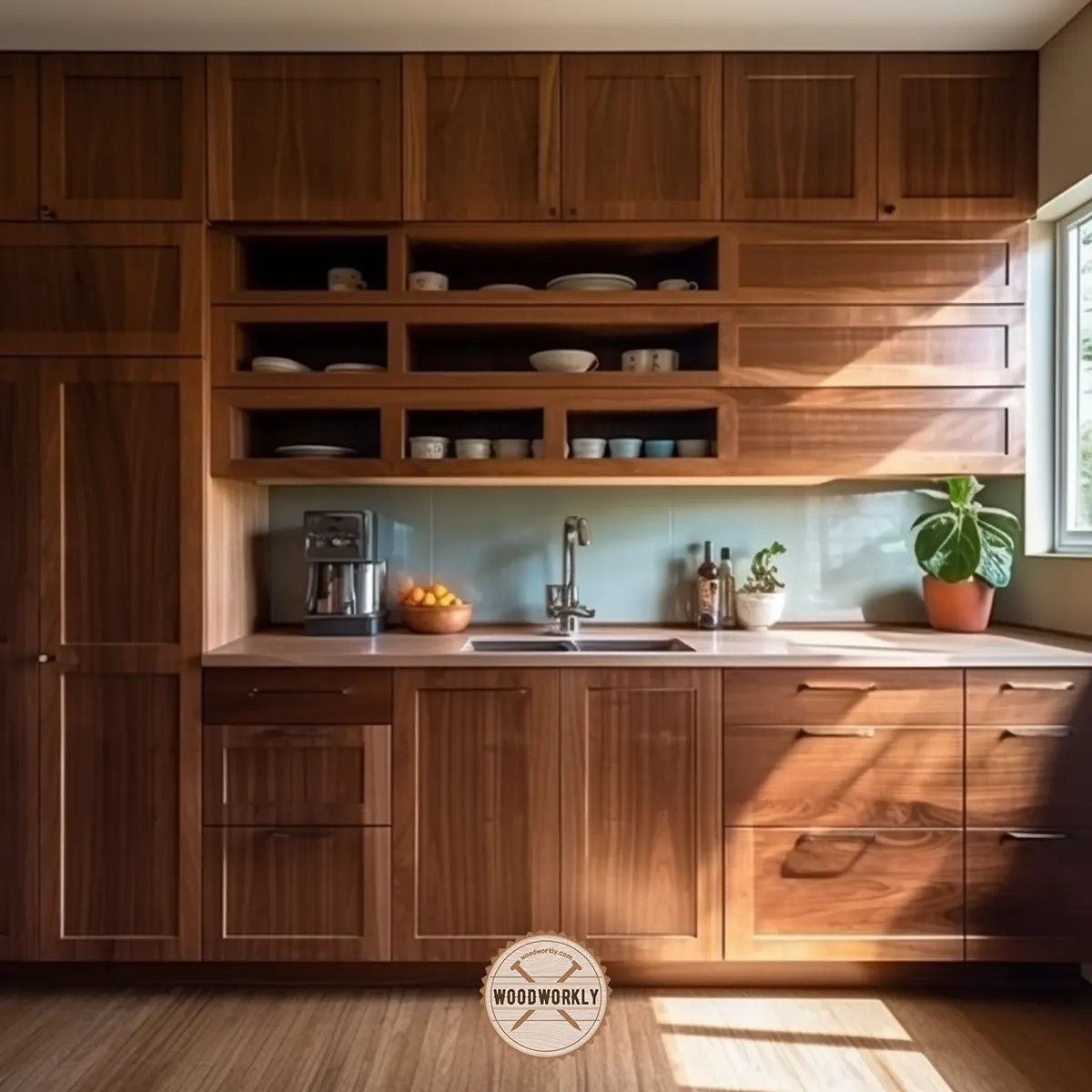
Pros and Cons of Walnut as a Cabinet Material
| Pros | Cons |
| Easy to stain and paint | Expensive |
| Eco-friendly option | Difficult to install |
| High durability | |
| Water-resistant | |
| Mold resistant |
12. Spruce
Spruce is a sturdy softwood that best wood for cabinets. It is a straight grain wood with a high hardness value. Therefore, Spruce cabinets are mostly used in shops and garages.
Spruce is lightweight, but it has one of the highest strengths to weight ratios among many kinds of wood.
Therefore, Spruce cabinets are extremely strong despite being lightweight.
Spruce cabinets have a modern pleasing look because of their creamy white color.
Because of having smaller knots compared to wood types like Pine, Spruce has higher dimensional stability and can use as industrial cabinet material.
Spruce cabinets are durable the wood is so easy to work with.
Even a beginner in woodworking can use Spruce to learn cabinet-making techniques because of its user-friendliness.
Finishing and gluing Spruce is easy, and it takes stain so well. Therefore, you can protect Spruce cabinets from water damage especially if you’re working on a bathroom cabinet application or outdoor cabinet.
Read to know, Is Spruce good for outdoor use?
When you’re using construction lumber, kiln-dried woods are only dried with 12% -15% moisture content.
Furniture-grade lumber is dried with 5% -8% moisture content. Therefore, make sure to bring wood to your woodworking area at least a couple of weeks before using it.
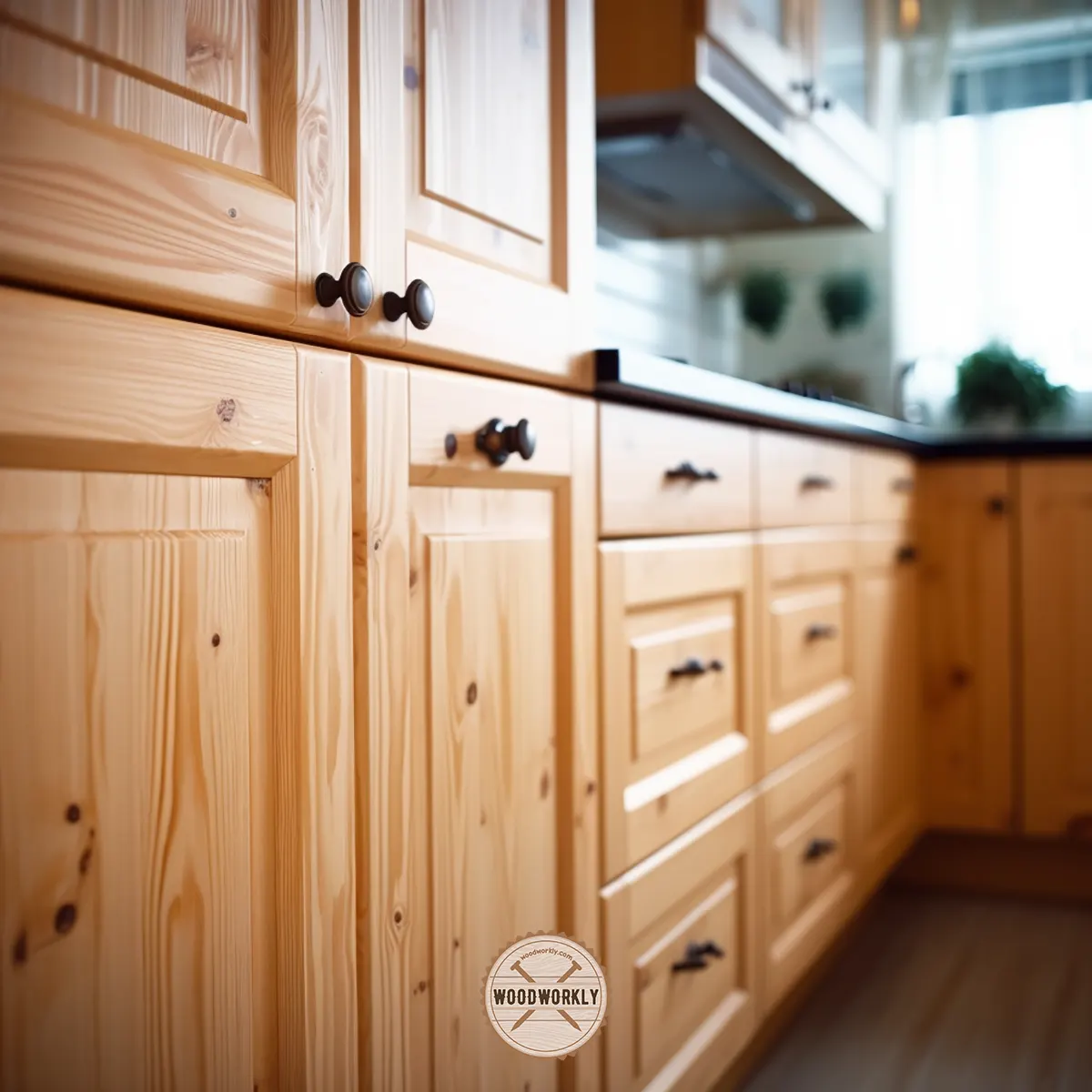
Pros and Cons of Spruce as a Cabinet Material
| Pros | Cons |
| Lightweight | No decay resistance |
| High flexibility | Less durability |
| High strength to weight ratio | Susceptible to insect attacks |
| Easy to stain and paint | |
| Affordable | |
| Attractive uniform texture |
13. Douglas Fir
Douglas Fir is an intense solid wood that is popular in cabinet making. It is softwood but sturdy because of its fiber structure.
Douglas Fir is mostly used for kitchen cabinets. It is fire resistant and can withstand the heat produced in the kitchen. It is the best wood for cabinets in the kitchen.
In terms of durability, Douglas Fir is not durable as hardwoods. But with proper finishing and regular maintenance, Douglas Fir cabinets will easily last over years.
Nailing, screwing, and gluing Douglas Fir is easy because of its high machinability. Even a beginner in woodworking can learn cabinet making with Douglas Fir.
Douglas Fir has a light brown color that varies on its age. It has a straight grain pattern with medium to a coarse texture that adds a unique aesthetic appearance to your cabinets.
Ultimately, Douglas Fir is a perfect choice for cabinets. It is a lightweight softwood with moderate workability.
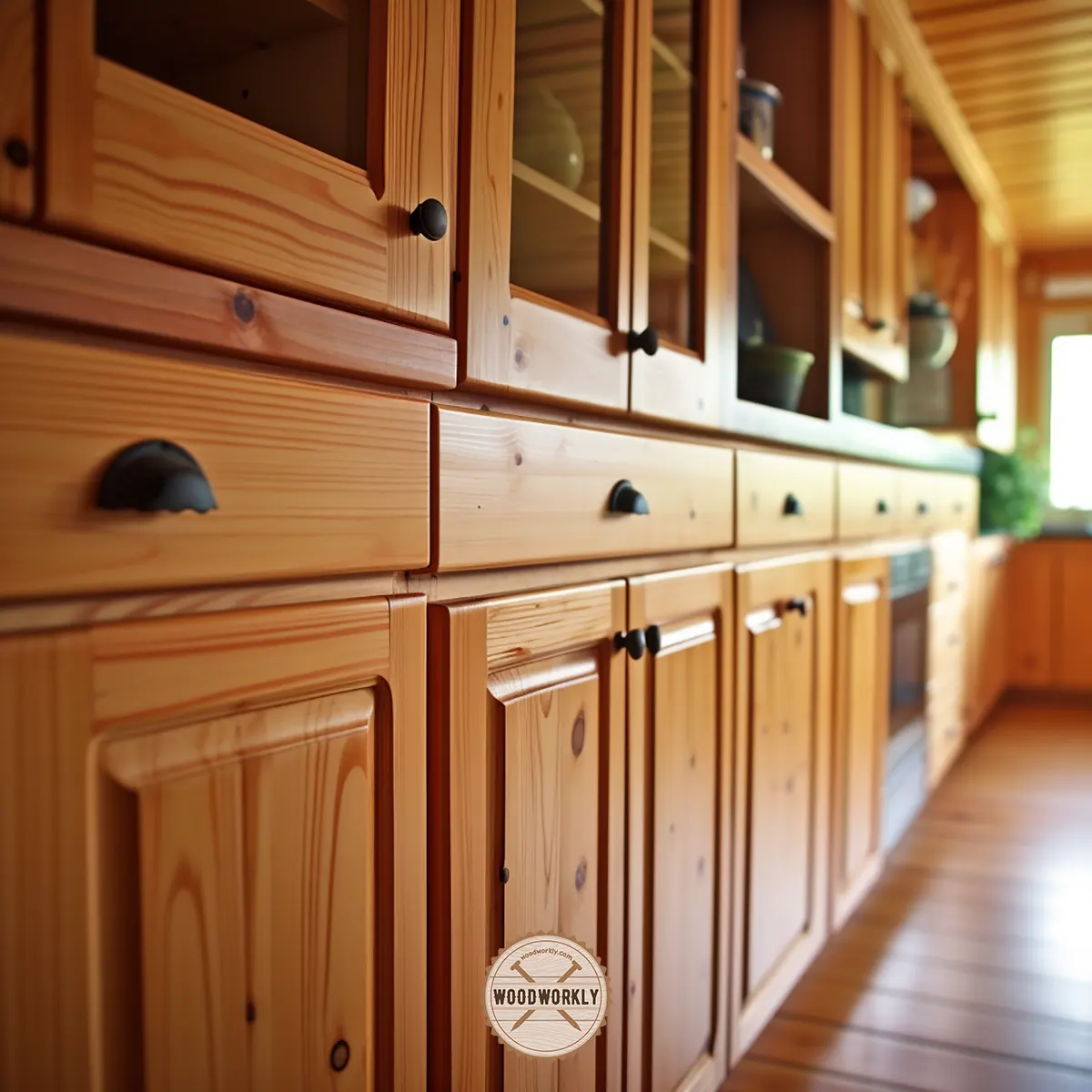
Pros and Cons of Douglas Fir as a Cabinet Material
| Pros | Cons |
| Versatile | Poor rot resistance |
| High flexibility | Low hardness |
| Affordable | Not durable as hardwoods without proper finishing |
| Chemical-free | Susceptible to insect attacks |
| Decay resistant | Need regular maintenance |
14. Alder
If you’re looking for wood for cabinets, with properties of both hardwoods and softwoods, Alder is the best wood for cabinets you should go with.
Because even though Alder belongs to the hardwood family, it is extremely soft and has high workability with woodworking tools.
It is a durable wood with straight grain and a uniform smooth texture which adds a unique feel to your cabinets.
Knotty Alder is popular among woodworkers for cabinet doors because it has a rustic natural beauty that enhances the quality of the woodwork.
Alder is an attractive wood with many finishing options. Alder cabinets can be designed to match your kitchen, office, dining room, or bathroom.
But because of being too soft, Alder is prone to wear and tear. It has poor scratch and dent resistance.
Therefore, better not to place heavy items on Alder cabinets because they can cause wood chipping and cracking.
Staining and painting Alder wood are so much easy. It will stain evenly without making random blotches and streaks.
But if you notice blotches in Alder wood surface after staining, better to sand it down and apply pre-stain wood conditioner first and then go for the staining part.
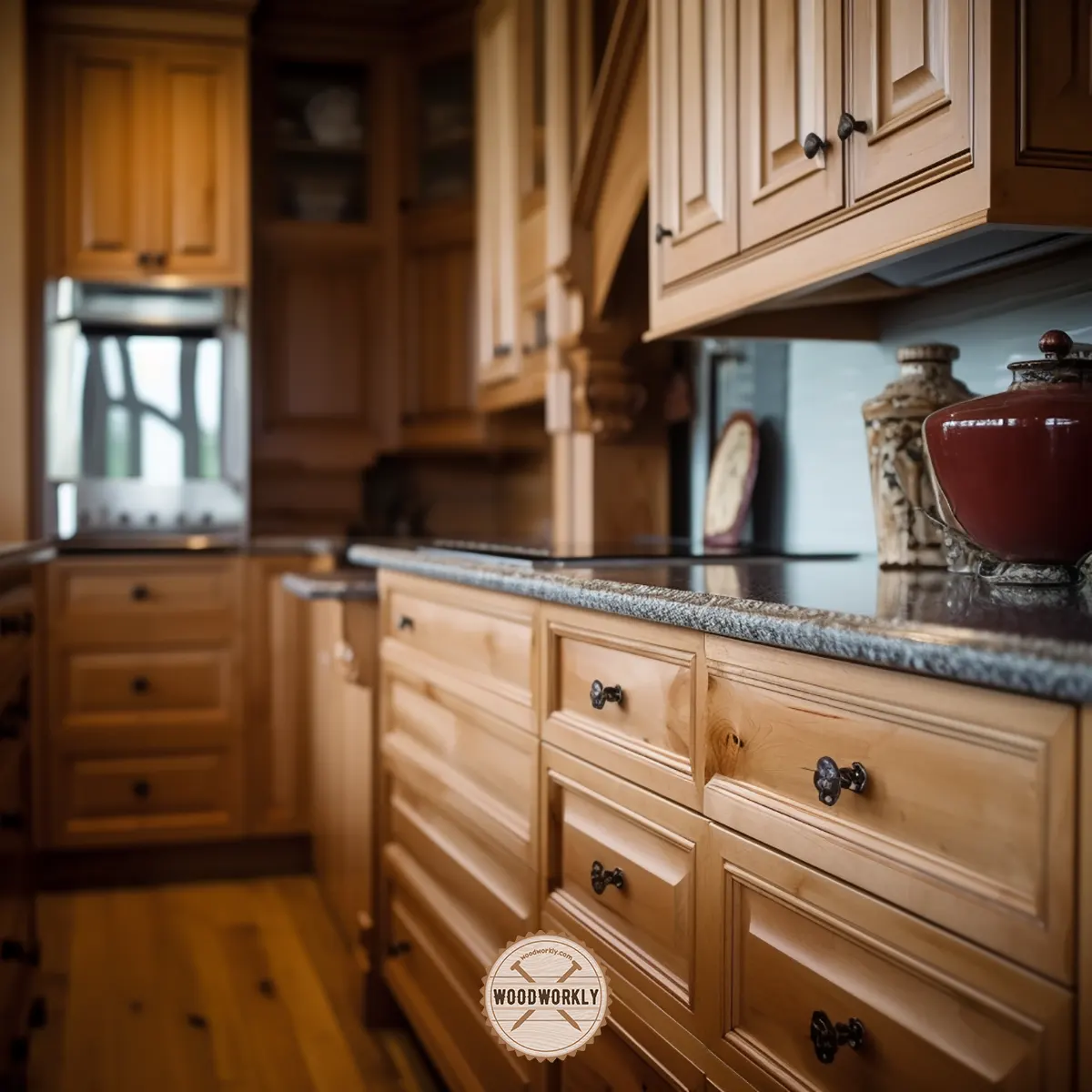
Pros and Cons of Douglas Fir as a Cabinet Material
| Pros | Cons |
| Beautiful appearance | Prone to scratches and dents |
| Easy to stain and paint | Poor hardness |
| High workability | Too soft |
| Versatility | |
| Eco-friendly option | |
| High availability |
15. Bamboo
Bamboo is extremely strong with high compressive and tensile strength. It is one of the most trending woods for cabinets.
It has superior strength to weight ratio. Therefore, it’s so strong for its weight. It can be considered the best wood for cabinets.
Bamboo has high structural integrity, and it is able to withstand high stress. Therefore, Bamboo cabinets can hold heavy items without chipping or cracking the wood.
Bamboo has high resistance to dings, chips, cracks, and splits.
It has a unique straight grain with distinctive knuckles and nodes. It is softer than most hardwoods but in terms of strength, it’s unbeatable.
In terms of appearance, Bamboo provides a natural warm fresh look to your cabinets with a neutral hue. It comes in white and honey colors.
Bamboo is easy to stain. It takes stain so well and mostly water-based stains go well with Bamboo.
The wood itself is resistant to dents and scratches. Therefore, the durability of Bamboo cabinets is quite high.
Bamboo is an affordable option for woodworkers with a tight budget. With all the excellent qualities Bamboo is well worth the price.
Usually, Bamboo is stronger than most hardwoods and softwoods.
- Bamboo is 38% stronger than Douglas Fir
- Bamboo is 109% stronger than White Pine
- Bamboo is stiffer than White Pine
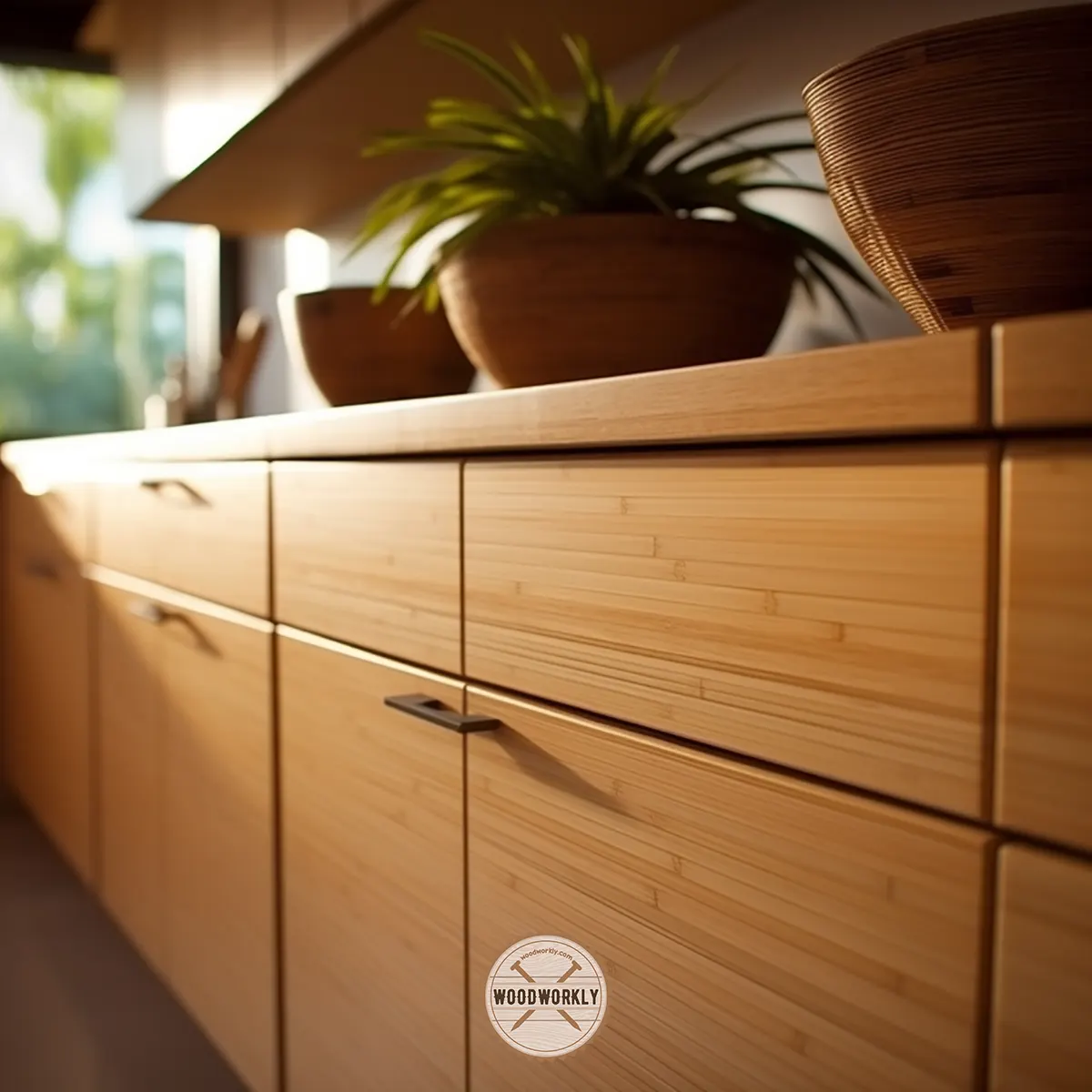
Pros and Cons of Bamboo as a Cabinet Material
| Pros | Cons |
| Versatile | Susceptible to deterioration |
| Strong | Different quality variations |
| High durability | Hard to work with |
| Easy installation | |
| Water resistance |
16. Plywood
Nowadays there are houses, where all the kitchen furniture, cabinets, and bathroom furniture are constructed with Plywood.
Plywood is a manufactured wood type that can use for both dining area cabinets and kitchen cabinets.
Plywood cabinets are extremely durable and strong as solid wood cabinets.
Sometimes stronger! It is one of the best wood for cabinets.
Plywood is popular for frameless cabinets which are trending across Europe. Plywood cabinets are not only used for house interiors but also for construction purposes.
Cabinet-grade Plywood contains twice the number of plies, a super smooth finish, and good lamination.
Because of having a protective layer and a high number of plies, Plywood cabinets are string and have good resistance against scratches.
It is lightweight and easy to install. Therefore, there’s very less possibility of going in the wrong direction in handling and installing Plywood cabinets.
Birch, Pine, and Maple Plywood are not recommended to stain. They are difficult to stain and have a high possibility of gaining random blotchy surfaces and streaks.
They are so hard and dense. Stain pigments are hard to penetrate through those kinds of woods and difficult to give even tone across the Plywood.
Make sure to check the following factors before choosing the best Plywood for cabinets.
- Flatness of Plywood
- Edge thickness
- Graining pattern
- Damages
- Avoid subgrade core materials
- Look for curves
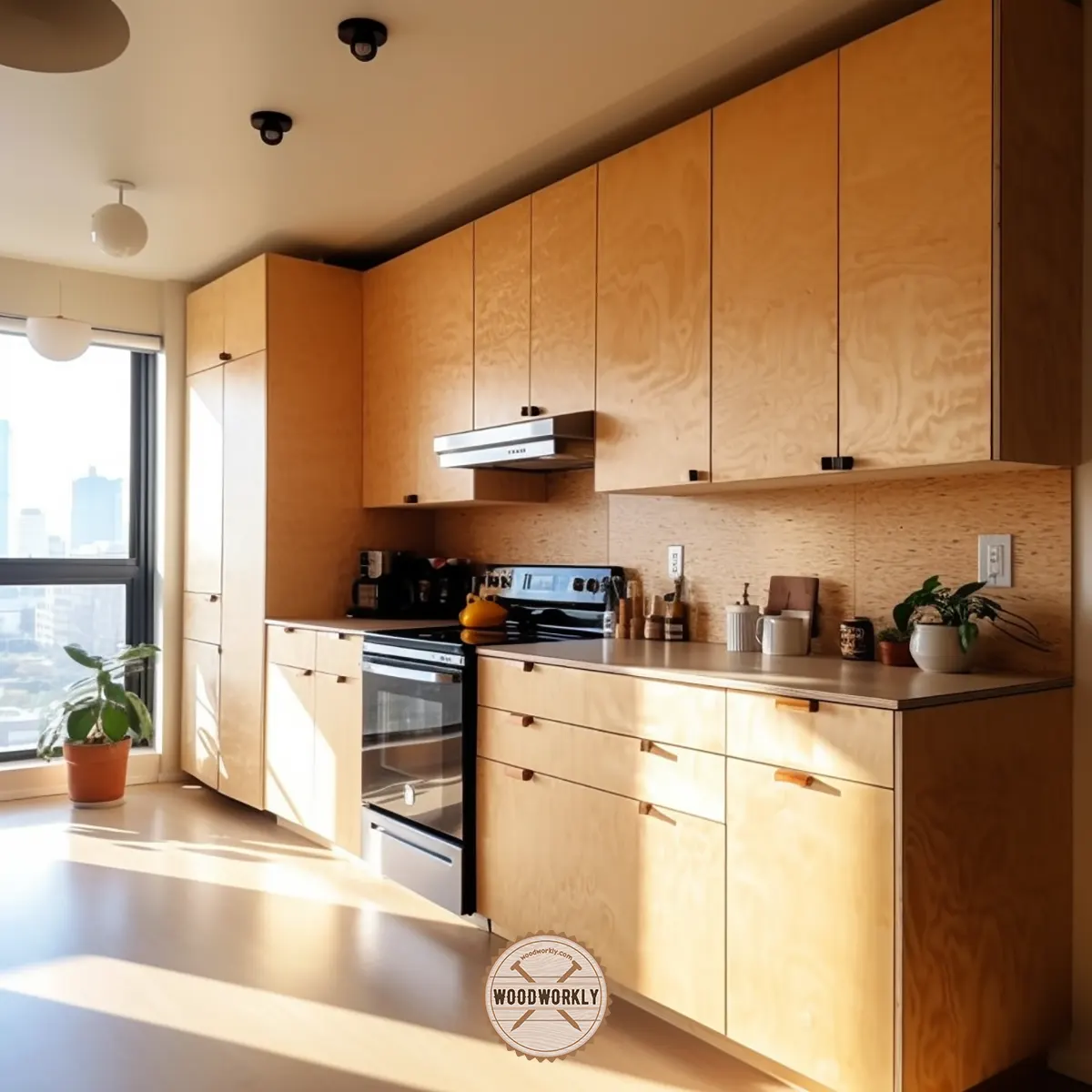
Pros and Cons of Plywood as a Cabinet Material
| Pros | Cons |
| High stiffness | Less durability |
| Comes in many sizes and thicknesses | Susceptible to water damages |
| Extremely strong | Difficult to sand and paint |
| Can bend | |
| High workability | |
| Affordable | |
| Lightweight | |
| Able to cut in any shape |
That’s it, folks! Now you know the best wood for cabinets.
Now, let’s talk about the best wood for cabinets in for specific applications.
What is the Best Wood for Kitchen Cabinets?
Here’s the best wood for kitchen cabinets,
- Oak
- Pine
- Maple
- Cherry
- Birch
- Hickory
- Ash
The above woods, work well for making kitchen cabinets giving exceptional qualities.
Best Wood for Painted Cabinets
Here’s the best wood for painted cabinets,
- Alder
- Soft Maple
- Hard Maple
- Beech
- Ash
- Oak
- Poplar
The above woods are so strong and have great hardness to use for painted cabinets. So, no worries!
best wood for cabinet doors
All the woods are suitable for making cabinets and good for making cabinet doors as well.
Here’s the best wood for cabinet doors,
- Cherry
- Maple
- Oak
- Hickory
- Walnut
- Birch
- Alder
- Ash
- Mahogany
- Teak
Now you know the best woods for cabinets in different applications.
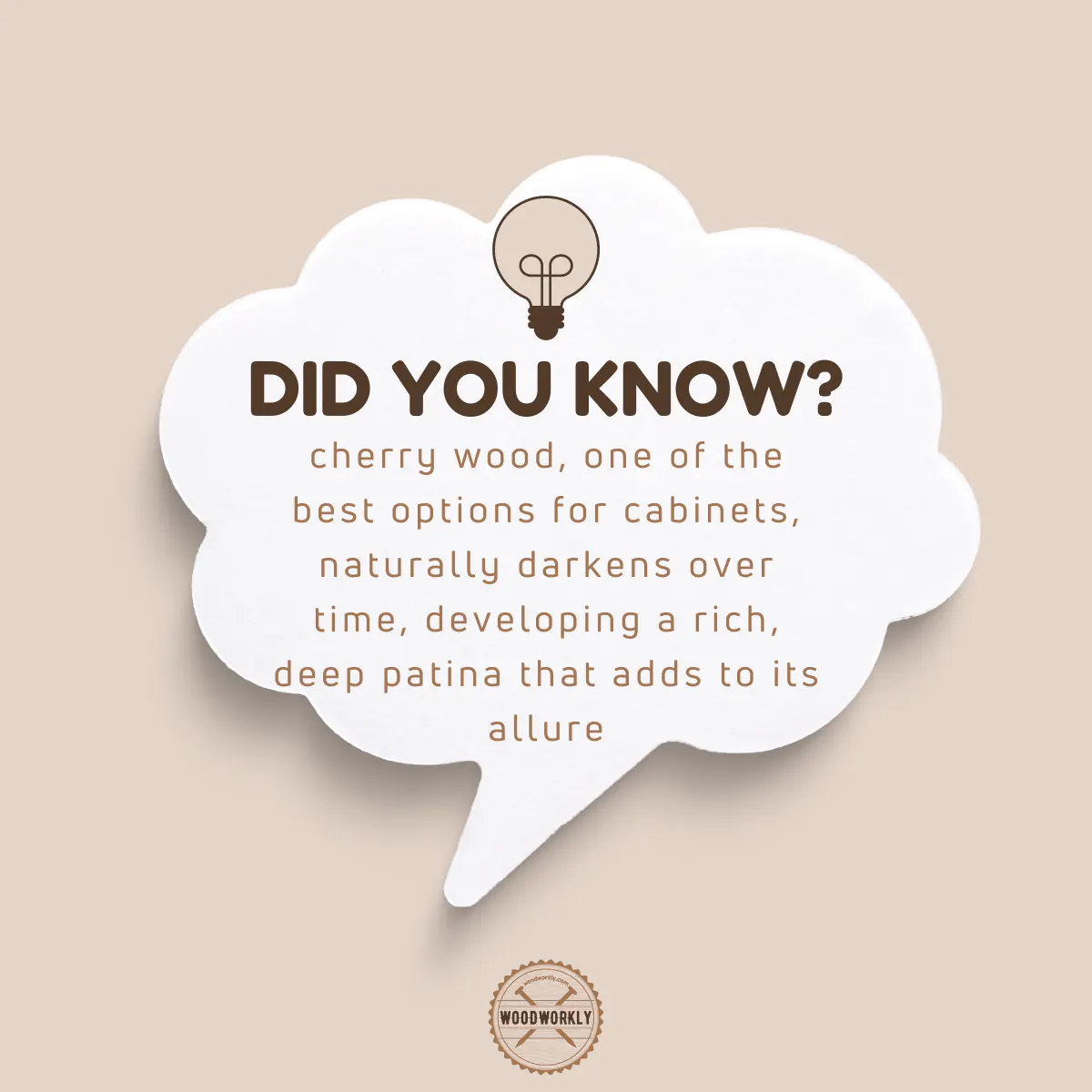
So, let’s answer some frequently asked questions as well.
What are the top hardwood choices for cabinets?
Maple, cherry, and oak are popular hardwood options, each offering unique benefits; maple’s subtle grain suits modern designs, cherry’s rich color adds warmth, and oak’s durability ensures longevity.
Can I use softwoods for cabinetry?
Yes, softwoods like pine or alder can be used for cabinetry; however, they’re more prone to dents and scratches, so consider them for low-traffic areas or if you’re seeking a rustic aesthetic.
How do I determine the quality of wood for cabinets?
Inspect the wood for consistent color, uniform grain patterns, and minimal knots or imperfections; also, pay attention to the cabinet construction and joinery techniques for an overall assessment.
Is engineered wood a good alternative for cabinets?
Engineered wood, like plywood or MDF, can be cost-effective and stable alternatives, especially when finished with a high-quality veneer that mimics the appearance of natural wood.
How do I ensure my cabinets’ longevity?
Choose durable wood species, invest in quality construction, and follow proper maintenance procedures, such as cleaning with a damp cloth and avoiding abrasive cleaners or excessive moisture.
Can I mix different wood species in my cabinet design?
Absolutely! Mixing wood species can add visual interest; just be mindful of maintaining a cohesive design by considering color tones, grain patterns, and finish compatibility.
Are there eco-friendly wood options for cabinets?
Yes, options like bamboo, reclaimed wood, or FSC-certified lumber from responsibly managed forests can help you create environmentally friendly cabinets.
What is the most durable wood for cabinets?
Hardwoods like oak, maple, and cherry are among the most durable choices for cabinets, offering excellent resistance to wear and tear, scratches, and dents.
Which wood is most expensive for cabinets?
High-end hardwoods like walnut, mahogany, and teak are typically the most expensive choices for cabinets, prized for their rich colors, beautiful grain patterns, and exceptional durability.
What is the best wood thickness for cabinets?
The ideal wood thickness for cabinets varies, but 3/4-inch plywood is commonly used for cabinet boxes and shelves, while 1/2-inch to 5/8-inch thickness is suitable for door panels and drawer fronts.
Did I cover all you wanted to know about Best Wood For Cabinets?
In this article, I’ve deeply discussed the 16 best wood for cabinets by taking their properties, qualities, pros, and cons.
I have discussed why those woods are considered the best wood for cabinets and how their unique qualities are important in cabinet making.
The best wood for cabinets typically includes hardwoods like maple, cherry, and oak, as they offer durability, aesthetics, and stain resistance. Other options include engineered wood products like MDF or plywood, which are cost-effective and stable, especially when finished with high-quality veneers.
As you can see almost all the wood is best for cabinets if you treat them well with regular maintenance.
With proper finishing and woodworking techniques, you’ll be able to make any wood strong enough to use as cabinet material.
Furthermore, I’ve answered some frequently asked questions about the best wood for cabinets with examples.
Hope you have gained good knowledge about woods that use most for cabinet making and why are they so special.
Now let’s work on your cabinet-making project with all the gathered information from this article. Have fun in woodworking!
I love Douglas Fir for kitchen cabinets. We had ours for years, and they are still looking great.